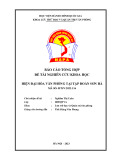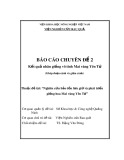
BioMed Central
Page 1 of 6
(page number not for citation purposes)
Cough
Open Access
Research
Phosphodiesterase 3 inhibition and cough in elderly asthmatics
Yoshihisa Ishiura*1, Masaki Fujimura2, Kouichi Nobata2, Miki Abo1,
Takayoshi Oribe1, Shigeharu Myou2 and Hiroyuki Nakamura1
Address: 1The Department of Internal Medicine, Toyama City Hospital, Toyama, Japan and 2Respiratory Medicine, Cellular Transplantation
Biology, Kanazawa University Graduate School of Medicine, Kanazawa, Japan
Email: Yoshihisa Ishiura* - ishiura@tch.toyama.toyama.jp; Masaki Fujimura - fujimura@med3.m.kanazawa-u.ac.jp;
Kouichi Nobata - nobata@med3.m.kanazawa-u.ac.jp; Miki Abo - abo@med3.m.kanazawa-u.ac.jp; Takayoshi Oribe - orib@med3.m.kanazawa-
u.ac.jp; Shigeharu Myou - myou@med3.m.kanazawa-u.ac.jp; Hiroyuki Nakamura - nakamura-h@tch.toyama.toyama.jp
* Corresponding author
cough reflex sensitivitycapsaicincilostazolphosphodiesterasebronchial asthma
Abstract
Aims: Cough is a common symptom of bronchial asthma, a chronic inflammatory airway disease.
Recently, the therapeutic effects of selective phosphodiesterase (PDE) inhibitors have been focused
on bronchial asthma. This study was designed to investigate the clinical effect of PDE 3 inhibition
on cough reflex sensitivity in elderly patients with bronchial asthma.
Methods: Effects of cilostazol, a PDE 3 inhibitor, on cough response to inhaled capsaicin were
examined in 11 patients over 70 years with stable asthma in a randomized, placebo-controlled cross
over study. Capsaicin cough threshold, defined as the lowest concentration of capsaicin eliciting five
or more coughs, was measured as an index of airway cough reflex sensitivity.
Results: The cough threshold was significantly (p < 0.05) increased after two-week treatment with
cilostazol (100 mg twice a day orally) compared with placebo [48.8 (GSEM 1.4) vs. 29.2 (GSEM 1.3)
µM].
Conclusion: These findings indicate that PDE 3 inhibition may be a novel therapeutic option for
elderly patients with asthma, especially for their cough symptoms.
Introduction
Chronic cough is a frequent problem in general practice
and one of the commonest reasons for referral to respira-
tory clinic. A patient's quality of life becomes severely
affected through loss of sleep, interruption of work and
social embarrassment. Every effort should be made to
clarify the cause of cough because specific therapy has a
higher likelihood of success than empirical therapy. A pre-
vious study revealed that patients with persistent cough
had three times the risk of developing chronic wheezing
as compared to normal subjects [2]. Thus, it is important
to disclose the mechanism of persistent cough and to
develop more efficacious treatment. Though cough has
been considered to result from stimulation of airway sen-
sory nerve endings within the respiratory tract [1], the
potential mechanism by which the cough reflex may be
altered in humans remains obscure.
Published: 24 November 2005
Cough 2005, 1:11 doi:10.1186/1745-9974-1-11
Received: 05 June 2005
Accepted: 24 November 2005
This article is available from: http://www.coughjournal.com/content/1/1/11
© 2005 Ishiura et al; licensee BioMed Central Ltd.
This is an Open Access article distributed under the terms of the Creative Commons Attribution License (http://creativecommons.org/licenses/by/2.0),
which permits unrestricted use, distribution, and reproduction in any medium, provided the original work is properly cited.

Cough 2005, 1:11 http://www.coughjournal.com/content/1/1/11
Page 2 of 6
(page number not for citation purposes)
Table 1: Clinical characteristics of asthmatic patients
Treatment
Patient
number
Age
(yr)
Sex Height
(cm)
Type Severity Total IgE in
serum
(IU/ml)
Specific IgE in
serum
Complication
of allergic
disease
RT20-FEV1
(mg/ml)*
Bronchodilat
or response
(%)**
BDP
(µg/day)
Theophylline
(mg/day)
Clenbuterol
(µg/day)
Carbocysteine
(mg/day)
1 81 M 154 Int Moderate 75 - - 2.50 34.0 800 0 40 1500
2 72 F 151 Ext Moderate 464 HD AR 2.50 25.4 800 0 0 0
3 80 F 143 Ext Moderate 3 Mite, HD - 1.25 27.0 800 0 40 0
4 72 F 148 Int Mild 28 - - 0.08 19.4 0 0 0 1000
5 79 F 142 Int Moderate 37 - - 5.00 27.6 800 0 20 1500
6 72 F 150 Int Moderate 57 - - 0.31 22.3 400 0 40 0
7 72 F 147 Ext Moderate 647 HD, Ceder - 0.31 31.8 800 0 20 1500
8 70 F 140 Int Moderate 17 - - 1.25 17.6 800 0 40 1500
9 75 M 162 Ext Moderate 148 HD, Ceder AR 2.50 14.1 800 0 40 1500
10 71 M 165 Ext Moderate 133 Mite, Ceder AR 1.25 14.6 0 0 40 1500
11 80 M 165 Int Moderate 2 - - 2.50 12.6 400 0 0 0
Ext, extrinsic; Int, intrinsic; HD, house dust; AR, allergic rhinitis; BDP, beclomethasone diproprionate inhalation.
*PC20-FEV1 shows concentration of inhaled methacholine causing a 20% fall in FEV1.
**Bronchodilator response means percent increase in forced expiratory volume in 1s (FEV1) from the baseline value after inhalation of 300 µg of salbutamol sulfate.
All patients used inhaled β2-agonists (salbutamol or procaterol) on demand.

Cough 2005, 1:11 http://www.coughjournal.com/content/1/1/11
Page 3 of 6
(page number not for citation purposes)
Recently, considerable attention has been focused on the
potential use of selective inhibitors of cyclic nucleotide
phosphodiesterases (PDEs) in the treatment of respiratory
diseases as PDE isoenzymes may play an important role in
the regulation of airway caliber and bronchial smooth
muscle function [3]. It has been shown that PDE 3 and
PDE 4 are the major adenosine 3' 5'-cyclic monophos-
phate (cyclic-AMP) – hydrolyzing enzymes and that
human airway smooth muscle contains isozymes of the
PDE families [4,5]. Furthermore, human lung tissue con-
tains multiple PDE isozymes [6]. Therefore, it is impor-
tant to determine the possible role of inhibition of these
PDE isozymes in vivo. Though previous research failed to
prove a bronchodilator effect of a PDE 3 and PDE 4 dual
inhibitor, zardaverine, in patients with partially reversible
chronic airway obstruction [7], others indicated the pro-
tective effect of selective PDE 3 and PDE 4 inhibitors [8,9].
We have demonstrated that a phosphodiesterase 3 inhib-
itor, cilostazol, reduces bronchial hyperresponsiveness to
inhaled methacholine in elderly patients with stable
asthma [10].
Based on these findings, this study was designed to eluci-
date the potential importance of orally administered
cilostazol on cough reflex sensitivity to inhaled capsaicin
in asthmatic elderly patients.
Subjects and Methods
Subjects
Eleven patients over 70 years with stable bronchial
asthma (4 males and 7 females) with a mean age of 74.9
± 1.3 (± SEM) (range 70–81) yrs participated in this study.
Individual data of capsaicin cough threshold before each treatment and after placebo and cilostazol treatments in elderly patients with stable bronchial asthmaFigure 1
Individual data of capsaicin cough threshold before each treatment and after placebo and cilostazol treatments in elderly
patients with stable bronchial asthma. Each horizontal bar represents geometric mean value. Closed circles and open circles
represent patients undergoing steroid inhalation therapy and patients without steroid inhalation therapy, respectively. P values:
Wilcoxon signed-ranks test using logarithmically transformed values.
.
1
1
1
0
10
0
100
0
Placebo
Wash out
Cilostazol
Run-in
P = 0.01
5
P = 0.02
4
P = 0.03
9

Cough 2005, 1:11 http://www.coughjournal.com/content/1/1/11
Page 4 of 6
(page number not for citation purposes)
All patients were lifetime nonsmokers or ex-smokers with
no history of viral infection for at least 4 weeks prior to the
study. Informed consent was obtained from all subjects.
Characteristics of individual patients are shown in table 1.
This study was approved by the Ethics Committee of our
hospital.
Each asthmatic patient satisfied the American Thoracic
Society definition of asthma, with symptoms of episodic
wheezing, cough, shortness of breath responding to bron-
chodilators and reversible airflow obstruction docu-
mented on at least one previous pulmonary function
study [11]. Reversibility was defined as greater than 12%
increase in the forced expiratory volume in one second
(FEV1) following inhalation of 200 µg salbutamol sulfate.
All patients had bronchial hyperresponsiveness as shown
in table 1 and were taking oral (short-acting clenbuterol)
and/or aerosol β2-agonists (short-acting procaterol),
inhaled steroids (beclomethasone dipropionate) and/or
mucolytic agents (carbocysteine). They had not received
oral theophylline or oral steroid therapy for at least eight
weeks. This study was carried out when their symptoms
were mild and stable.
Assessment of cough reflex sensitivity to inhaled capsaicin
Cough reflex sensitivity was assessed by a capsaicin prov-
ocation test [12]. Capsaicin (30.5 mg) was dissolved in
Tween 80 (1 mL) and ethanol (1 mL) and then dissolved
in physiological saline (8 mL) to make a stock solution of
1 × 10-2 M, which was stored at -20°C. This solution was
diluted with physiological saline to make solutions start-
ing at a concentration of 0.49 µM and increased by dou-
bling concentrations up to 1000 µM. Each subject inhaled
a control solution of physiological saline followed by pro-
gressively increasing concentrations of the capsaicin solu-
tion. Solutions were inhaled by the subjects for 15 s every
60 s, by tidal mouth-breathing whilst wearing a noseclip
from a Bennett Twin nebulizer (3012-60 cc, Puritan-Ben-
nett Co., Carlsbad, California, USA). Increasing concen-
trations were inhaled until five or more coughs were
elicited. The nebulizer output was 0.21 mL/min. The
number of capsaicin-induced coughs were counted by a
blindfolded medical technician in our pulmonary func-
tion laboratory. The cough threshold was defined as the
lowest concentration of capsaicin that elicited five or
more coughs.
Study protocol
The subjects' concomitant medication was stopped at
9.00 p.m. on the previous day to allow a washout time of
12 h or more before the measurement of cough threshold
to inhaled capsaicin at 10.00 a.m. on each test day to
reduce the diurnal variability of cough response.
Each patient attended 4 times, once every 2 weeks, at the
same time each day. A control measurement of capsaicin
cough threshold was carried out before the first treatment.
After a two week wash out period, treatment with cilosta-
zol and a placebo was performed in a randomized, cross-
over fashion, with a washout period of 2 weeks between
treatments. Two cilostazol tablets (100 mg) or their pla-
cebo were taken orally two times a day for 14 days at 8.00
a.m. on the test day. FEV1 was measured on a dry wedge
spirometer (Transfer Test, P.K. Morgan Ltd., UK) before
the capsaicin challenge to assess the bronchoactive effect
of the treatment regimens.
Data analysis
Capsaicin cough threshold values were expressed as a geo-
metric mean with a geometric standard error of the mean
(GSEM). Forced vital capacity (FVC) and FEV1 were shown
as arithmetic mean values ± SEM. The cough threshold,
the FVC and the FEV1 values were compared between each
pair of the four test periods (run-in, placebo treatment,
wash out and cilostazol treatment) by the Wilcoxon
signed-ranks test. Data was transformed to logarithmic
values for cough threshold at this test. A p-value of 0.05 or
less was taken as significant.
Results
Cough threshold to inhaled capsaicin before each treat-
ment (run-in and washout period) and after treatment
with cilostazol and placebo are shown in figure 1. Geo-
metric mean values for the cough threshold were 25.9
(GSEM 1.4) µM in run-in period, 27.5 (GSEM 1.4) µM in
washout period, 48.8 (GSEM 1.4) µM after cilostazol
treatment and 29.2 (GSEM 1.3) µM after placebo treat-
ment. The cough threshold after the cilostazol treatment
was significantly (p < 0.05) greater than the value after the
placebo treatment. FVC or FEV1 value was not signifi-
cantly different between run-in period, washout period,
cilostazol treatment and placebo treatment as shown in
table 2.
Table 2: Pulmonary function on cilostazol and placebo treatments in patients with bronchial asthma
Run-in Placebo Wash out Cilostazol
FVC as % pred. (%) 102.3 ± 5.7 104.7 ± 5.8 102.1 ± 5.1 108.4 ± 4.7
FEV1 as% pred. (%) 98.5 ± 8.2 100.4 ± 7.7 98.5 ± 6.6 106.3 ± 7.3
Data are shown as mean value ± standard error of the mean.

Cough 2005, 1:11 http://www.coughjournal.com/content/1/1/11
Page 5 of 6
(page number not for citation purposes)
There were no changes in serum IgE and peripheral blood
eosinophils, therefore, treatment with cilostazol did not
affect the IgE production or peripheral blood eosinophil
count. After the administration of cilostazol, none of the
patients complained of headache. Other adverse effects
such as palpitations, flushing and dizziness were not
observed with the cilostazol treatment in patients partici-
pating in this study, since the side effects of cilostazol are
less frequent in elderly patients as shown in our previous
study [10].
Discussion
The present study showed that two-week treatment with a
PDE 3 inhibitor, cilostazol, increased the cough threshold
to inhaled capsaicin in elderly patients with stable
asthma. No difference could be found in the baseline pul-
monary function, peripheral blood eosinophil counts and
IgE production between cilostazol and placebo treat-
ments. From these findings, PDE 3 inhibition may be use-
ful in elderly patients suffering from bronchial asthma,
especially cough predominant asthma.
Although cough is a protective reflex that facilitates the
expulsion of mucus from the airways, chronic cough
causes major functional limitation in a great number of
people who seek medical service. It is well known that
cough can be the sole manifestation in some asthmatic
patients [13], however, the precise mechanism correlating
to the cough reflex in this disorder remains obscure. A
recent study revealed that inflammatory mediators play
major roles in the pathogenesis of bronchial asthma,
however, the relationship between inflammatory media-
tors and airway cough reflex sensitivity also remains
unclear. Previous studies showed that some inflammatory
mediators can modulate the sensitivity of the cough reflex
[14,15]. We indicated that intrinsic thromboxane A2
(TxA2) is a possible modulator, augmenting both airway
cough reflex sensitivity and bronchial responsiveness
whilst not having a bronchoconstricting effect in stable
asthmatics [14,16,17]. Other studies reported that pros-
taglandin F2α (PGF2α) enhances airway cough reflex sen-
sitivity with bronchoconstricting effect [18,19]. It has also
been shown that inhaled prostaglandin E2 (PGE2), which
acts as a bronchodilator, enhances cough reflex sensitivity
[19,20]. These findings indicate the variable role of
inflammatory mediators in the local control of cough
reflex with no relation to bronchoconstriction.
Previous studies have shown the effects of selective inhibi-
tion of PDE isozymes in inhibition of inflammatory cell
function and relaxation of airway smooth muscle in asth-
matic airways [3-9,21]. Bachelet et al have shown that
alveolar macrophages from asthmatic patients have
increased PDE activity [22]. Other researchers have indi-
cated that PDE 3 is closely coupled to the regulation of
prostaglandin D2 (PGD2) generation [23]. Recently we
demonstrated the bronchoprotective effect of PDE 3 inhi-
bition in asthmatic patients [10,24,25], on the basis that
PDE 3 is indeed present in human airway smooth muscle
[26]. We, therefore, carried out this study on the assump-
tion that PDE 3 activity in an asthmatic airway might also
lead to increased sensitivity of airway cough response and
concluded that a selective PDE 3 inhibitor, cilostazol, can
modulate to reduce the airway cough sensitivity to
inhaled capsaicin. We also showed that there was no
improvement in lung function despite our previous study
[10]. Though the precise mechanism for this discordant
remains obscure, we stipulate that the difference in the
cilostazol administration period may be a possible cause
of the discordant, because in our previous study, bron-
chodilation was observed with a single administration of
cilostazol. Precise mechanisms for the improvement of
cough reflex sensitivity indicated in this study also
remains unclear because we did not measure PC20. One
of the possible mechanisms is that elevation of cyclic-
AMP induced by PDE 3 inhibition may play some role in
the regulation of cell activity and airway cough reflex sen-
sitivity [26].
Furthermore, the bronchoprotective effect of PDE 3 inhi-
bition for non-asthmatic subjects was not examined.
There is therefore a need for further studies in patients
with other bronchial disorders and normal subjects.
In conclusion, the present study clearly indicates that PDE
3 inhibition can attenuate cough reflex sensitivity in the
airways of elderly asthmatic patients. Oral administration
of cilostazol may be a novel therapeutic option for
patients with bronchial asthma, for whom cough is an
especially troublesome symptom. This is the first report
demonstrating the efficacy of PDE 3 inhibition in view of
cough reflex sensitivity in elderly asthmatics. Further stud-
ies are required to investigate the role of other PDE iso-
zymes in airway cough reflex sensitivity in bronchial
asthma.
Abbreviations
cyclic-AMP = adenosine 3' 5'-cyclic monophosphate; CVA
= cough variant asthma; FEV1 = forced expiratory volume
in one second; FVC = forced vital capacity; GSEM = geo-
metric standard error of the mean; PDE = phosphodieste-
rase; PGD2 = prostaglandin D2; PGE2 = prostaglandin E2;
PGF2α = prostaglandin F2α; TNF-α = tumor necrosis fac-
tor-α; TxA2 = thromboxane A2; TxB2 = thromboxane B2.
References
1. Irwin RS, Boulet LP, Cloutier MM, Fuller R, Gold PM, Hoffstein V, Ing
AJ, McCool D, O'Byrne P, Poe RH, Prakash UBS, Pratter MR, Rubin
BK: Managing cough as a defense mechanism and as a symp-
tom. Chest 1998, 114:133S-181S.




![PET/CT trong ung thư phổi: Báo cáo [Năm]](https://cdn.tailieu.vn/images/document/thumbnail/2024/20240705/sanhobien01/135x160/8121720150427.jpg)











![Báo cáo seminar chuyên ngành Công nghệ hóa học và thực phẩm [Mới nhất]](https://cdn.tailieu.vn/images/document/thumbnail/2025/20250711/hienkelvinzoi@gmail.com/135x160/47051752458701.jpg)









